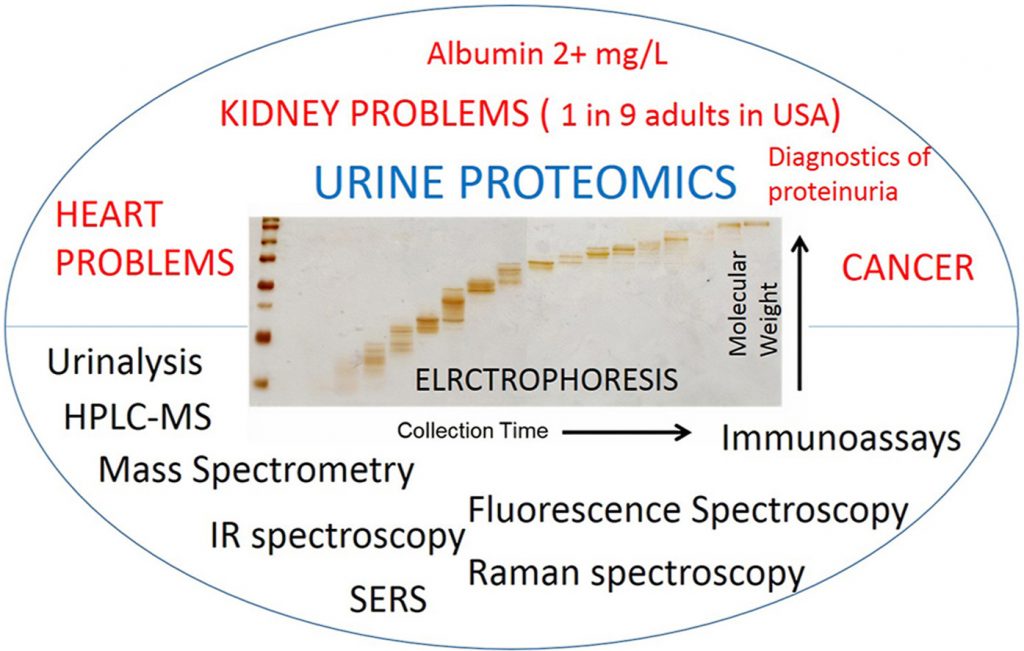
Research Interest
Areas of Interest in Chemistry: Analytical chemistry, Surface Enhanced Raman scattering, detection of biomolecules, top down nanofabrication, plasmonics, Surface Enhanced spectroscopy, Atomic Force Microscopy
Dr. Rostislav Bukasov grew up in Ukraine and earned his specialist degree in chemistry from Kharkiv National University in 1994. After working in National Center of Drug Research for two years, he was employed in and soon owned a small photo service business operating in Russia and Ukraine. Then he worked as an analytical chemist in pharmaceutical industry in Kharkiv for 15 month. He came to a Graduate School of Chemistry Department at University of Utah in Salt Lake City in 2004. He started research in Nanotechnology/Analytical Chemistry as a first graduate student of Dr. Shumaker Parry in 2005. His PhD study of unique, tunable infra-red plasmonic properties of nanocrescents resulted in three first author publications in Nano Letters (among 10% of the most cited publications (2007) in the most impactful journal of American Chemical Society (ACS) and the second most impactful journal in nanotechnology), ACS Nano and Analytical Chemistry. As a postdoctoral researcher in Dr. Marc Porter group in Nanoinstitute of Utah he studied/developed sandwich immunoassays with Surface Enhanced Raman Scattering, which are applicable for biodetection and medical diagnostics (early detection of cancer, tuberculosis, viruses, e.g).
Beyond chemistry Dr. Bukasov is proficient in hiking . He is exceptional in hiking/climbing with kids (e. g. Mt. Elbrus, 5642 m with 9 year old daughter Yunona Bukasova, more on www.kidsuperhiker.com). He does a good deal of intensive exercise, serious reading on a variety of subjects (usually in English), traveling, taking pictures and thinking.
Advice to students: Try to be as much a well rounded person as you can be, as long as you are still good in your profession or area of specialization. Study not just for the test to maximize your GPA but to understand principles and therefore to keep the knowledge for many years after graduation. Also remember what your president said during his lecture at NU: “Those who read books will be in charge of those who read mainly in Internet.“
Current News
Recently we got “ Review: Detection and quantification of proteins in human urine” ( authors Sultan Aitekenov, Abduzhappar Gaipov, Rostislav Bukasov* ( * corresponding author) ) published in TALANTA ( 90% percentile in Analytical Chemistry, Impact Factor 5.2). 90% percentile means that only 10% of journals have higher impact factor than this journal. https://doi.org/10.1016/j.talanta.2020.121718
This review paper was not planned or conceived before pandemics, but it came out as a result of intensive writing in several months of NU lab lockdown due to COVID quarantine. Sultan Aitekenov, a master’s degree graduate of Moscow State University, did a bulk of writing and data organization in this comprehensive article. It summarizes and reviews the results of 202 references in urine proteomics, spanning 20 pages of 2 columns text.
Highlights
- Urinary protein biomarkers are useful for diagnosis of many conditions: kidney and cardio vascular diseases, cancers.
- Liquid chromatography-mass spectroscopy is a powerful tool for urine proteomics, but used mostly in science.
- Immunoassays are widely used in both clinical and bio-analytical laboratories.
- IR and Raman spectroscopies are promising tools for diagnostics of urine due to low-cost and rapidness.
Abstract
Extensive medical research showed that patients, with high protein concentration in urine, have various kinds of kidney diseases, referred to as proteinuria. Urinary protein biomarkers are useful for diagnosis of many health conditions – kidney and cardio vascular diseases, cancers, diabetes, infections. This review focuses on the instrumental quantification (electrophoresis, chromatography, immunoassays, mass spectrometry, fluorescence spectroscopy, the infrared spectroscopy, and Raman spectroscopy) of proteins (the most of all albumin) in human urine matrix. Different techniques provide unique information on what
constituents of the urine are. Due to complex nature of urine, a separation step by electrophoresis or chromatography are often used for proteomics study of urine. Mass spectrometry is a powerful tool for the discovery and the analysis of biomarkers in urine, however, costs of the analysis are high, especially for quantitative analysis. Immunoassays, which often come with fluorescence detection, are major qualitative and quantitative tools in clinical analysis. While Infrared and Raman spectroscopies do not give extensive information about urine, they could become important tools for the routine clinical diagnostics of kidney problems, due to rapidness and low-cost. Thus, it is important to review all the applicable techniques and methods related to urine analysis. In this review, a brief overview of each technique’s principle is introduced. Where applicable, research papers about protein determination in urine are summarized with the main figures of merits, such as the limit of detection, the detectable range, recovery and accuracy, when available.

2020 List of Publications
1. High Contrast Surface Enhanced Fluorescence of Carbon Dot Labeled Bacteria Cells on Aluminum Foil
Rostislav Bukasov, Zhanar Kunushpayeva, Alisher Rapikov, Saida Zhunussova, Alisher Sultangaziyev, Olena Filchakova
Journal of Fluorescence 30 (2020) 1477–1482
Zhanar Kunushpayeva, AlisherRapikov, Aktilek Akhmetova, Alisher Sultangaziyev, Dina Dossym, Rostislav Bukasov
Sensing and Bio-Sensing Research 29 (2020) 100355
Abduzhappar Gaipov, Zhandos Utegulov, Rostislav Bukasov, Duman Turebekov, Pavel Tarlykov, Zhannur Markhametova, Zhangatay Nurekeyev, Zhanar Kunushpayeva, Alisher Sultangaziyev
BMC Nephrology 21 (2020) 229
Alisher Sultangaziyev, Aktilek Akhmetova, Zhanar Kunushpayeva, Alisher Rapikov, Olena Filchakova, RostislavBukasov
Sensing and Bio-Sensing Research 28 (2020) 100332
5. Review: Detection and quantification of proteins in human urine
Sultan Aitekenov, Abduzhappar Gaipov, Rostislav Bukasov
Talanta (2020) in press DOI:10.1016/j.talanta.2020.121718 (IF: 5.339)
Alisher Sultangaziyev, Rostislav Bukasov
Sensing and Bio-Sensing Research 30 (2020) 100382
7. Detection of RNA viruses from influenza and HIV to Ebola and SARS-CoV-2: a review
Rostislav Bukasov, Dina Dossym, Olena Filchakova
Analytical Methods (2020) accepted
Fall 2023
- CHEM 220 – Quantitative Chemical Analysis
- CHEM 520 – Applied Analytical Chemistry
- CHEM 720 – Spectrochemical Methods of Analysis
- CHEM 591 – Scientific Methods in Chemistry (team-taught course)
- CHEM 700 – Hot Topics in Chemistry (team-taught course)
Spring 2023
- CHEM 320 – Instrumental Analysis
- CHEM 320L – Instrumental Analysis Lab
Fall 2022
- CHEM 220 – Quantitative Chemical Analysis
- CHEM 520 – Applied Analytical Chemistry
- CHEM 720 – Spectrochemical Methods of Analysis
Fall 2021
- CHEM 220 – Quantitative Chemical Analysis
- CHEM 520 – Applied Analytical Chemistry
Spring 2021
- CHEM 320 – Instrumental Analysis
- CHEM 320L – Instrumental Analysis Lab



